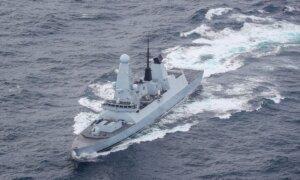Defense Secretary Lloyd Austin has ordered the aircraft carrier USS Gerald R. Ford to remain in the Mediterranean Sea near Israel amid continuing concerns about volatility in the Middle East, according to multiple reports.
It’s the third time the aircraft carrier’s deployment has been prolonged because of the ongoing conflict between Israel and the Hamas terrorist group in Gaza, USNI News reported.
Aside from the Ford, the USS Dwight D. Eisenhower carrier strike group was also stationed in the Middle East.
The United States first moved the Ford to the Eastern Mediterranean on Oct. 8—a day after Hamas launched its terror attack on Israel. Defense officials said the aircraft carrier will remain there for “several more weeks,” The Associated Press reported.
US Troops Have Done ‘Incredible Service’
A senior defense official told reporters that the troops “are missing the holidays with their families, and they have done an incredible service—not only for our country but for the region.”“What this visit to the Ford is about is an acknowledgment that we demonstrated what the National Defense Strategy means,” the senior official said.
“The Department of Defense retains the capability to dynamically and expeditiously flow force into any theater in response to a crisis or contingency while maintaining our commitments in other theaters. And that is exactly what we’ve done.”
The senior official said Mr. Austin also will meet with Israeli military leaders to discuss the country’s next steps in the conflict after an eventual cessation of high-intensity ground operations and airstrikes.
“[Secretary Austin] has been having discussions with his Israeli counterparts the entire time about the different phases of their campaign, how they assess the different phases of their campaign, and what their operational milestones are in order to feel that their population can be secure enough, given their stated objective of the military dismantlement of Hamas.
“He wants to talk to them about how you move through those different phases,” the senior official said.
However, the senior official emphasized that Israel will have to determine “when they assess that Hamas has been sufficiently degraded [so] that they can shift to the next phase of their campaign.”
The Pentagon ramped up its military presence in the region after Hamas’s Oct. 7 attacks to deter Iran from widening the war into a regional conflict. Since then, Iranian-backed militants in Iraq and Syria have seized on the war to conduct regular attacks with rockets, drones, and missiles on U.S. military installations in the region.

At the same time, U.S. warships in the Red Sea have intercepted incoming missiles fired toward Israel from areas of Yemen controlled by Iranian-backed Houthi rebels.
They’ve also shot down one-way attack drones headed toward the ships and responded to calls for assistance from commercial vessels that have come under persistent Houthi attacks near the narrow Bab el-Mandeb strait.
As of Dec. 15, there are 19 U.S. warships in the region, including seven in the eastern Mediterranean and 12 across the Red Sea, Arabian Sea, and the Persian Gulf.







